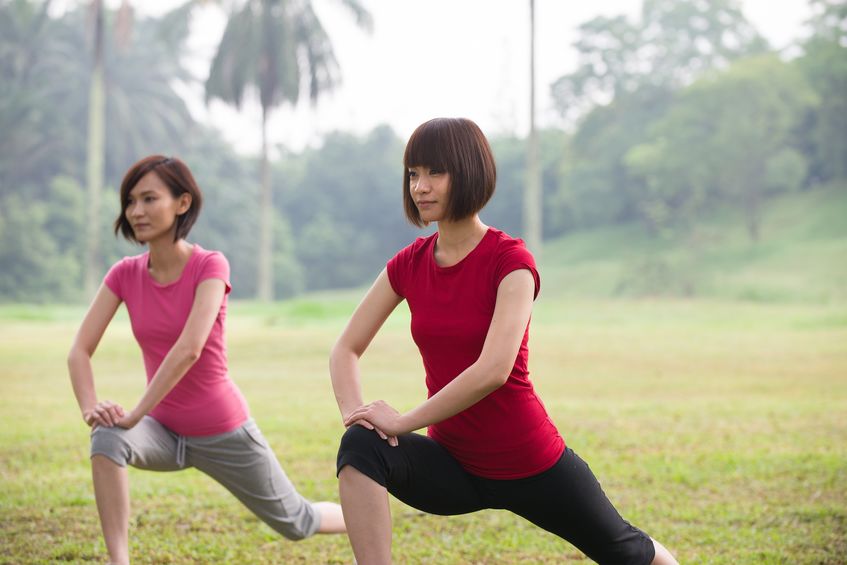Outdoor Safety and Health Considerations
1) Hot weather: While Phoenix is running the highs on the dry heat, many places in the country are also known for humidity. Mind the weather and weather advisories from local weather authorities before heading out for the day. Try to schedule clients before the heat of the day in the morning or towards the evening as it’s cooling off. If nighttime is an option, go for it! Many locales have well-lit city parks that can be utilized after hours or even tennis courts that aren’t being used.
2) Inclement weather: It’s always good to be aware if a storm is coming. At best, these can be a nuisance like a light sprinkle, making it unsafe to run or making fitness equipment slippery, or at worst, a major outdoor safety concern. You don’t want to be caught in a tropical storm, hurricane, blizzard (winter), tornado, etc.
3) Hydration: This is always important when training clients but becomes even more so outdoors in the summer. Make sure to remind clients to bring water. If you’re able to, bring extras for them. If they continue to forget, (unless they’re kids or under the age of 18), this is a teachable opportunity for clients to learn to be prepared for sessions.
4) Hydration packets/electrolytes: Sometimes water is not enough to re-hydrate, depending upon the Frequency, Intensity, Time, and Type of exercise. Endurance training will deplete electrolytes the most. In this case, it can be beneficial to encourage clients to have electrolyte products or drinks to re-hydrate.
6) Adequate caloric intake pre- & post workout: If clients have a usual “routine” of feeding pre- & post-workout it’s good to let them know if the place where the exercising will take place is close to their vehicles or not. If it’s a bit of a trek, they should bring their pre- & post-workout calories with them.
7) Sunscreen/sunblock: This is good practice to use even when it is overcast as UV rays can impact skin whether it’s a bright and sunny day or cloudy. Some sunscreen products are better choices for skin health than others.
9) Headwear: For those experiencing hair loss, thinning hairline, or sensitive scalp, wearing a hat or some form of head covering is advisable. Those who experience excessive sweating may want to wear a headband or bandana.
101) Towels: Clients should bring their own, especially if prone to perspiration. If you’re able to provide towels for clients, you may consider a fee for those who want to “rent” them or have a “towel service” similar to fitness facilities.

Additional Outdoor Safety Tips and Consideriations
1) Permission to use the facilities/course for business: Some outdoor areas require registering with the parks department or whoever owns the property before using it for business purposes. Due diligence is required to acquire any necessary usage permit that reserves the spot for you and allows you to conduct business there. Some parks prevent business and finance transactions to occur on grounds.
2) Liability insurance/coverage: If you carry your own liability insurance (which, if you’re taking on personal training clients for your business, you most likely do), make sure to notify your carrier and put the outdoor facility onto your insurance policy. This is no different than if you are adding a location or moving location; you need to notify your liability insurance carrier.
3) Outdoors training liability waiver: If you have your own Fit Pro business, chances are, you already have a liability waiver you’re using. Consider adding these two before starting to work with clients outdoors and during the COVID-19 Pandemic.
4) Facilities/bathrooms: Some outdoor parks and locations have public bathroom access but are time-limited. If you are going after hours, check with staff or the parks department about facility hours. Also, make sure these facilities are accessible due to COVID-19 social distancing safety rules.
5) Park access hours: Based on my experience doing personal training outdoors, most of my clients were available before or after business hours and on weekends. Weekends for park access weren’t usually a challenge but 4:30/5 AM starts were! Sometimes parks are only open from dawn to dusk, requiring coordination or identifying a park or outdoor location that is open to accommodate the hours.
6) Keep credentials handy (business card, CPR Card, copy of your CPT Cert): This is important because you never know who will be curious and come by to ask what you’re doing. Some onlookers might be interested in joining! Keeping a folder, picture, or app that contains your credentials will allow you to share your contact info with a prospect. Also, there may be routine patrols of park staff checking these things, so it’s important not to be caught off-guard. I was able to use parks or fields attached to schools during off-hours and these credentials were necessary to show school security and patrolmen at times so they could ensure the safety of the grounds.
7) Client information (emergency contact, pertinent medical information, etc.): However you decide to keep this info confidential while being outdoors is up to you. There are apps that can hold onto this or you can have a locked box in your car. You never know what can happen. If your clients are adults, they are of legal age, but they are also your client and their safety is your responsibility. While you aren’t a medical professional, if an EMT needs to be called to the site, you’ll want this information handy.
8) Proper outdoor fitness attire and shoes (different needs vs. indoor fitness facility): I was amazed at how many clients would come to outdoor training sessions clad for the fitness center. The surfaces outdoors are not the same as inside a fitness center; different footwear is needed. It’s important to let clients know this upfront and discuss options.
9) Fit pro buddy system: If you’re solo, let a fellow fit pro, friend/family member know or use an app to ‘check in’. If you’re teaming up, let your team know. Inside a fitness facility, other staff and patrons can see you and know where you are. Not true when you turn to the great outdoors. This step would be similar to letting another individual know prior to going on a hike. Safety first!
10) Irrigation/other park maintenance: Arizona and its dry weather dry up the soil really fast. Therefore, we irrigate. When I first moved here from NY, I was amazed to see baseball fields, soccer fields, grassy knolls, and lawns “flooded.” I learned about irrigation, where water is released into the area and saturates the ground in order to allow the soil to become moist and support growth for grass and stuff.
Imagine my chagrin when I would arrive at a park and it would be flooded due to irrigation! If you live in a zone that irrigates, inquire about the irrigation schedule so you and your clients are not flooded out. Also, many outdoor parks have routine landscaping and other such maintenance. Find out when those are so that you aren’t scrambling for alternatives or rescheduling due to landscaper interference.
11) Plan equipment: This one is important to develop and create a well-hatched plan. I’d encourage using equipment that’s portable and multi-use as much as possible or finding ways to use park fixtures or finding a fitness trail. Outdoor fitness-friendly equipment includes adjustable dumbells, kettlebells, resistance bands, agility ladders, cones, weighted vest, and medicine balls. Also, be mindful that if you’re on rugged terrain, items such as a stability ball might puncture and you might want to invest in heavier-duty yoga mats or even use outdoor camping pads.
12) Equipment Logistics: Whether you do small group fitness training or just 1:1 training, you can ask clients to help carry the equipment to the spot where you’ll be exercising with you as part of warm-up and bring it back as cool-down. Alternatively, you can arrive early and do it yourself if you know you have multiple sessions. I found most clients very graciously offer to help out.
13) Finding each other: A top outdoor safety consideration is not getting lost or losing your clients! If you are doing multiple sessions and are going to be there before them, let them know where in the park/outdoor facility they can find you. If you will be arriving at the same time, let them know where in the parking lot you will meet and whether they need to be ready to walk to the location or not. Drop a pin and text them for convenience. One thing you don’t want to encounter is compromising the safety of a client in an unfamiliar outdoor space.
14) Extra Garbage bags: Be responsible! Most parks will have garbage receptacles, but some are carry-in, carry-out. If you’re going to be training in the latter, keep extra bags handy!
While these safety tips may seem like a lot to plan for and remember, what you don’t have to worry about is overhead! Enjoy your outdoor training sessions smartly and it will all become second nature.



